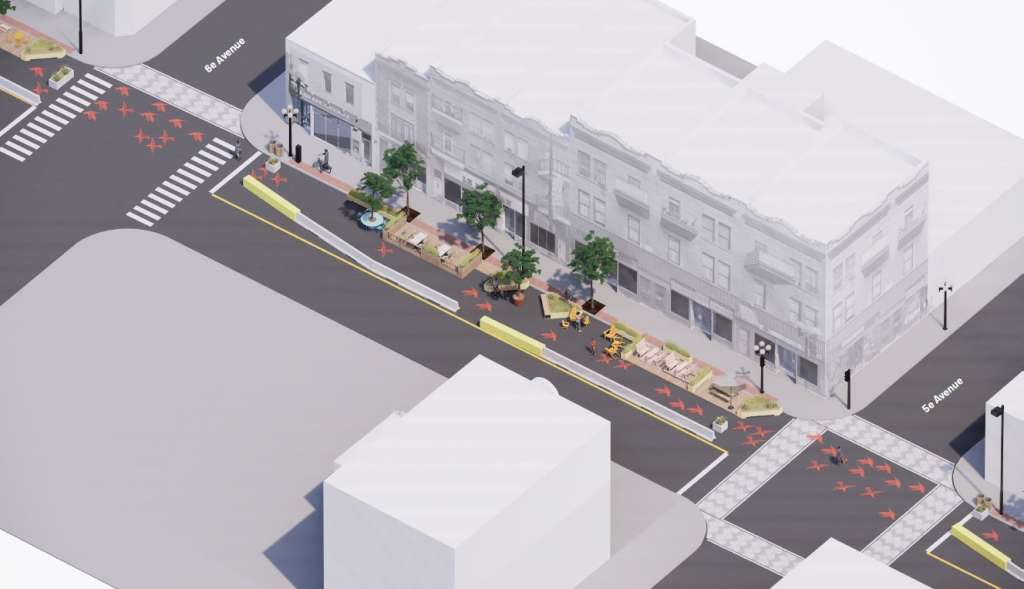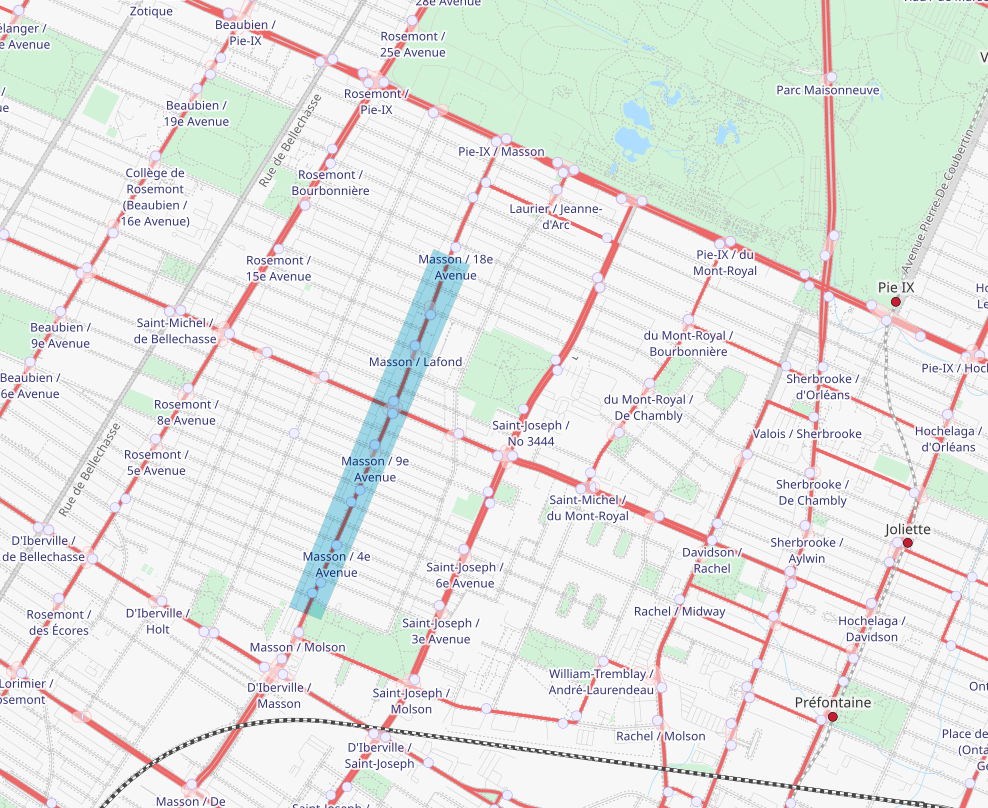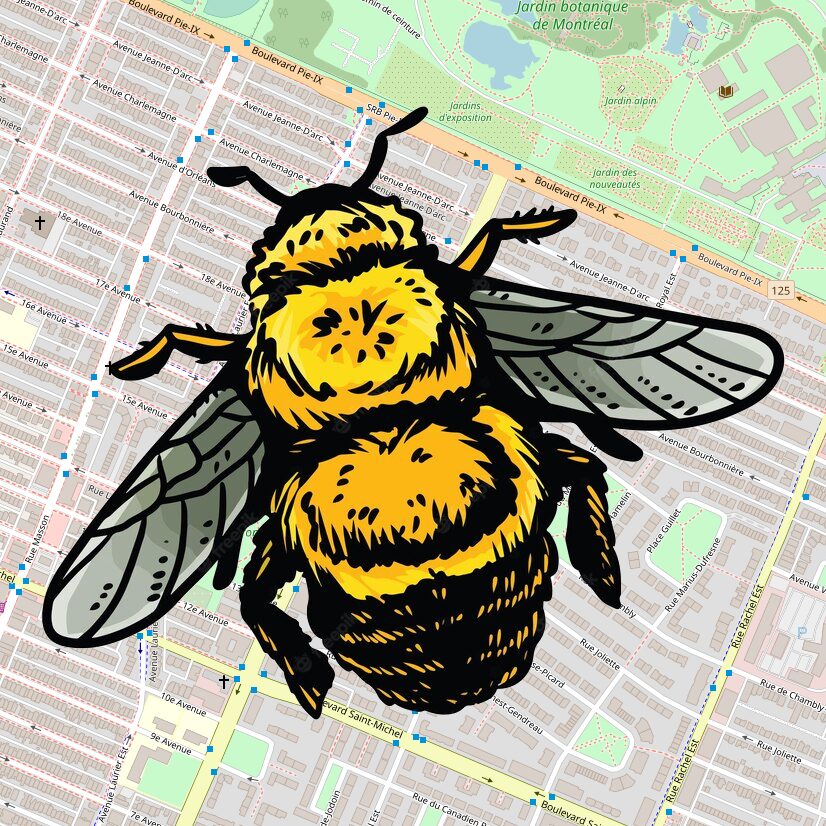In late 2023, I received a flyer in my mailbox from the City of Montréal. They were looking for feedback on a plan to revitalize the promenade of Rue Masson — an area that I live close to and frequent on a regular basis.
The area is in some ways nicer than a lot of streets in Montréal. In some areas it has extended curbs to slow traffic and create more space for benches, planters, and bike racks. There are trees. Businesses are close to the sidewalk, allowing for window shopping.

But the area has become quite run-down thanks to years of neglect on maintenance. In my research, I was able to find photos of the area as far back as 2007 where the benches and planters in the area were already crumbling, so one could say it’s long past time for the area to be revitalized. I was very excited, and immediately went to take the survey that was linked.
Community engagement: marking up the map
One interesting aspect of this project has been the way in which the city has solicited community engagement.
Rather than only asking residents to complete a survey, the city also provided a website where residents could add notes to the map voicing their complaints about the current state of the street, and suggestions for things they’d like to see.
(As an aside, this website uses OpenStreetMap data via Mapbox tiles, without attribution. Shame! 🔔🔔🔔)
It seems that this approach was rather popular. I counted responses from more than 65 individual people, some of whom had a lot to say. Here are some of the common threads I noticed among the comments:
Talk about widening sidewalks, securing crosswalks, and fully pedestrianizing the street were quite popular, with comments by a total of 13 people that I could see. (I didn’t count my own responses for any of these numbers.) Accessibility was mentioned by 4 people, specifically wishing that all stores could be forced to have accessible entrances if the sidewalks were widened or the road pedestrianized.
Though I didn’t count the number of comments, several people mentioned improving the infrastructure at bus stops. One complaint I made and that others seem to agree on is that waiting for the bus on Rue Masson is not very nice. Most stops lack shelters or benches, and often the only place to stand is on the sidewalk, leaving very little room for people to walk by. And because the lanes for cars are so close, it’s common to get sprayed by water when they drive by on rainy days. Most of these comments also mentioned widening the sidewalks, so they are largely account for in the above count of people asking for better pedestrian infrastructure.
Bicycle infrastructure was mentioned by 9 people. Connecting existing bike lanes and adding more bike parking were the common themes. I myself asked for improved bicycle parking, since currently it’s common to see bikes locked to sign posts or even trees on busy days.
But the one thing that all residents seem to agree on? Cars are not a positive contribution to the street. I counted comments from 31 people complaining about the sound and smell of cars, the high speed at which they travel on certain streets, and the way that they endanger pedestrians. This topic was by far the one with the most people talking about it on the feedback site.
So even though the idea of full pedestrianization was not expressed explicitly by a lot of people, it seems that many would enjoy the benefits that would come with a pedestrianized street. In fact, in 2021 the street was given over to pedestrians on one side to allow for social distancing, and I have never seen the area more alive.
Improving life for car drivers was only mentioned by 3 residents, all of which were complaining about the amount of parking available in the borough. Hopefully if pedestrianization is successful, more residents will be able to leave their cars at home — or get rid of them entirely! — making the parking situation better for residents who need to keep their cars for one reason or another.



Thinking beyond this project
This project is limited in its scope. The city states that it will only take place between a stretch that starts at Parc du Pélican at the west, reaching as far east as 17e Avenue.
Despite the prominent bounding box on the map and the instructions to only comment on areas within that box, 13 residents commented on areas further east of 17e Avenue. The majority of these comments express the same desire: extend this revitalization project further east! Many argued that it should go as far as Boulevard Pie-IX, given that there are businesses along the entire street.
As Jason Slaughter of NotJustBikes commented in a recent video about Montréal, Montréal has some great pedestrian areas. What it lacks is a network of these areas: each is an isolated island surrounded by streets that are not walkable.

Map © Ville de Montréal.
In order to attract pedestrians to an area, they need to be able to get there in a way that feels convenient and safe. This is why continuing this project east to Boulevard Pie-IX is an absolute must in order for it to maximize its success. While pedestrianization on the western end would make the area nicer for residents who already frequent the promenade, the lack of transit in the area will mean that people from elsewhere in the city will not consider it a destination unless it connects to major arteries.
The only protected cycling infrastructure that would connect to the new promenade in its current scope is the 1re Avenue bike track. Extending the project further east would allow a connection to the new cycleway on Avenue Bourbonnière, which is currently the best north–south cycle route in the area, connecting Rosemont and Hochelaga with smooth pavement, controlled crossings, and physical division from car traffic.
Thanks to the new rapid bus infrastructure on Boulevard Pie-IX and its connection to the Métro, it is one of the best routes for transit users in the area at this time. Its bus stops with large, well-lit shelters and real-time next bus displays make it the clear choice over other north–south arteries. Boulevard Saint-Michel — which connects directly to the Masson promenade — was one of the most complained-about streets by residents who responded to this engagement project. Residents feel unsafe walking or waiting for the bus there. To assume that transit users will brave this obstacle to visit the revitalized Masson promenade is probably assuming too much.

Map © OpenStreetMap contributors
In recent years, Montréal has done a great job of expanding and connecting its bike infrastructure. The REV is slowly becoming a web of interconnected streets that allow cyclists to travel all over the city on safe, fast routes. It’s time to do the same with its pedestrian-focused spaces.
Getting radical
One final thing that many residents agreed on is that the unsightly abandoned buildings and lots need to go. A total of 15 people made comments about the boarded-up former KFC and Jiffy Lube lots, many of them expressing a wish for the city to buy the lots and do something with them. Both community gathering spaces and affordable housing were mentioned.
It’s not so simple to reclaim abandoned lots with the laws we have in place, but it doesn’t have to be that way. France tabled a bill in 2021 that would — among other things — accelerate the ability for communities to recover abandoned property to just ten years, compared to 30 years under previous rules. A law under the same name passed in 2022 with overwhelming support from parliament, though I could not find details on whether or not the abandoned property clause was included.
Montréal passed a new bylaw in 2023 that levies hefty fines against the owners of buildings left in disrepair. Fines of up to $40,000 can be applied for non-heritage buildings left in disrepair, though even fines such as these may not persuade some property owners to sell. Residents should not have to tolerate derelict buildings in the heart of their boroughs for decades on end while the owners speculate on the real estate market, and nothing short of taking those properties from them will truly put a stop to it.
In conclusion
Though work on the project is not scheduled to begin until 2026, I’m very excited for Rue Masson’s future. Currently it is a neglected but well-loved place, and I hope that the residents’ passionate feedback will be taken into consideration by the city. It would be wonderful to have a fully pedestrianized promenade in the heart of Rosemont, akin to Rue Ontario in Hochelaga or Rue Mont-Royal in the Plateau. Rue Masson is already a destination for many residents, and it can only get better with redevelopment oriented around people, rather than cars.

Leave a Reply